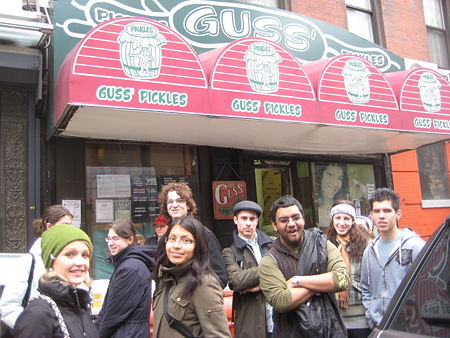From The Peopling of New York City
Archival Visits
We have visited various archives, digging into those records and collections that social historians know and love. Our journeys have led us to many places where historical memories of the elusive immigrant are kept, including the Municipal Archives on Chambers Street, home to the birth, marriage, and death certificates that provide clues to past lives, as well as census data, city directories, and other vital records that can tell us a little bit more about people who tend to disappear from the historical record. We have also visited Ancestry.com and other on-line sites, searching the census, combing ship manifests, and looking for other clues about the people we hoped to know more fully. Of course, we have also scrolled through newspapers, both on-line and via microfilm. We have visited the New York Public Library, the New York Historical Society, and other research libraries and archives as well, all in the hope of finding background information and other possible leads. And, when really lucky, we have gained access to manuscript collections that contain remnants from the lives of the immigrants we have hoped to find.

Walking Tours
We have embarked upon three walking tours: first through Lower Manhattan, including places where slave markets thrived along the waterfront, into City Hall Park where slave executions once took place, and on to the African Burial Ground, a sacred place hidden among and behind the political and economic life of the city; second, from the Battery, where many immigrants and migrants debarked after a grueling Atlantic voyage, we followed the immigrant trek both east and west, traveling some 5 miles inland to follow Eastern Europeans and others who have made their way to immigrant enclaves in Chinatown, the East Village, the Lower East Side, Greenwich Village, and beyond (including to the many burial sites where some of them are now interred, such as the all-but-forgotten First Shearith Israel Cemetery located near Chatham Square, and founded by Spanish and Portuguese Jews who first immigrated to New York during the 17th century and continue to remind us of previous eras; and finally, to Ellis Island itself, that infamous place where many of the immigrants we have encountered this semester made their first connection with New York and the United States.
The Scholars Who Inspired Us
Of course, to assist us with our efforts, we first had to turn to "the professionals"--those historians, journalists, and other scholars schooled in the arts of detection. Over the semester, we have read about ordinary immigrants and migrants involving themselves (whether they wanted to do so or not) in slave conspiracies and executions, in mysterious deaths and investigations, in riots and compromises, in earning their daily bread, in struggling to survive, and in vocal activism as part of larger quests for social justice in New York City and the wider nation and world. Along the way, authors have shared their insights and the tricks of their trade. And we have attempted to replicate their efforts.
For example, Jill Lepore, a Harvard professor, cultural historian, and much-sought-after essayist for magazines such as The New Yorker and Harpers, bequeathed to us her knowledge about and skills at unraveling historical mysteries. In an appendix to her New York Burning: Liberty, Slavery, and Conspiracy in Eighteenth-Century Manhattan, Lepore also provided an excellent list of everyday slave holders and slaves involved in events that resulted in rumors of conspiracy, city-wide hysteria, and the interrogation and execution of dozens slaves in Lower Manhattan during 1741. Although no real proof of a slave conspiracy (to burn Manhattan and kill all of the whites dwelling there) ever materialized, many innocent people lost their lives.
These people hailed from Europe and the African Diaspora, making their way to New York City from England, Scotland, France, the Netherlands, Spain, Portugal, Africa, and assorted places in the Caribbean. Ten of us decided to see what we might find in the historical record about what happenend to some of the immigrant slave owners (and possibly their surviving slaves) listed in Lepore's appendix. With each of us taking five of the people listed, we hoped to answer some questions about 50 particular immigrant New Yorkers. What sorts of lives did they lead in the wake of the so-called slave conspiracy? Did they and their family members continue to profit from the Atlantic slave trade and America's "peculiar institution," or did the loss of their "property" in 1741 change the course of their lives in important ways? Most of us never found materials that could help us answer those questions, but we learned other important things as we wended our way through different archives around New York City, in a quest to find colonial immigrants who eluded us more often than not. Elusive or not, our immigrants allowed us to enjoy some success in the archives, which we would like to share with you.
David Von Drehle, a journalist for the Washington Post, shared his detective skills as well, and provided us with yet another opportunity to investigate immigrant lives, this time among people who had arrived in the United States as part of a historic wave of international migration during the late 19th and early 20th centuries. And, in part, they made their mark on the United States as unfortunate participants in America's textile industry sweatshops.
In his Triangle: The Fire That Change America, Von Drehle traces the tragic events that resulted in the death of at least 146 sweatshop workers, most of them recent immigrants representing waves of Eastern European Jews and Italians fleeing religious and political persecution as well as starvation. Von Drehle, like Lepore, bequeathed to us a list of those victims (and their respective addresses), so that we might attempt to find out about the lives they had led before their tragic deaths, as well as what became of the family members and friends who resided with and identified them in the aftermath of March 25, 1911.